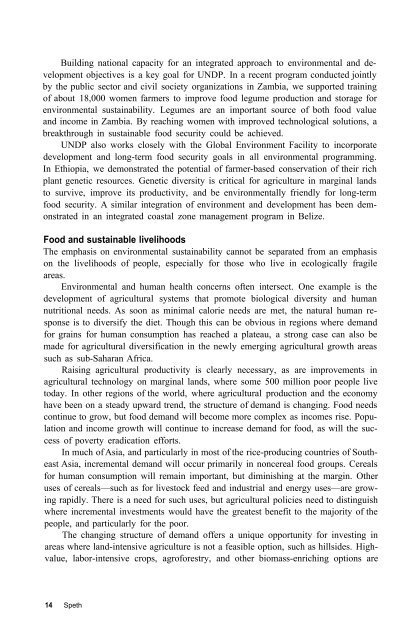Sustainability of rice in the global food system - IRRI books
Sustainability of rice in the global food system - IRRI books
Sustainability of rice in the global food system - IRRI books
You also want an ePaper? Increase the reach of your titles
YUMPU automatically turns print PDFs into web optimized ePapers that Google loves.
Build<strong>in</strong>g national capacity for an <strong>in</strong>tegrated approach to environmental and development<br />
objectives is a key goal for UNDP. In a recent program conducted jo<strong>in</strong>tly<br />
by <strong>the</strong> public sector and civil society organizations <strong>in</strong> Zambia, we supported tra<strong>in</strong><strong>in</strong>g<br />
<strong>of</strong> about 18,000 women farmers to improve <strong>food</strong> legume production and storage for<br />
environmental susta<strong>in</strong>ability. Legumes are an important source <strong>of</strong> both <strong>food</strong> value<br />
and <strong>in</strong>come <strong>in</strong> Zambia. By reach<strong>in</strong>g women with improved technological solutions, a<br />
breakthrough <strong>in</strong> susta<strong>in</strong>able <strong>food</strong> security could be achieved.<br />
UNDP also works closely with <strong>the</strong> Global Environment Facility to <strong>in</strong>corporate<br />
development and long-term <strong>food</strong> security goals <strong>in</strong> all environmental programm<strong>in</strong>g.<br />
In Ethiopia, we demonstrated <strong>the</strong> potential <strong>of</strong> farmer-based conservation <strong>of</strong> <strong>the</strong>ir rich<br />
plant genetic resources. Genetic diversity is critical for agriculture <strong>in</strong> marg<strong>in</strong>al lands<br />
to survive, improve its productivity, and be environmentally friendly for long-term<br />
<strong>food</strong> security. A similar <strong>in</strong>tegration <strong>of</strong> environment and development has been demonstrated<br />
<strong>in</strong> an <strong>in</strong>tegrated coastal zone management program <strong>in</strong> Belize.<br />
Food and susta<strong>in</strong>able livelihoods<br />
The emphasis on environmental susta<strong>in</strong>ability cannot be separated from an emphasis<br />
on <strong>the</strong> livelihoods <strong>of</strong> people, especially for those who live <strong>in</strong> ecologically fragile<br />
areas.<br />
Environmental and human health concerns <strong>of</strong>ten <strong>in</strong>tersect. One example is <strong>the</strong><br />
development <strong>of</strong> agricultural <strong>system</strong>s that promote biological diversity and human<br />
nutritional needs. As soon as m<strong>in</strong>imal calorie needs are met, <strong>the</strong> natural human response<br />
is to diversify <strong>the</strong> diet. Though this can be obvious <strong>in</strong> regions where demand<br />
for gra<strong>in</strong>s for human consumption has reached a plateau, a strong case can also be<br />
made for agricultural diversification <strong>in</strong> <strong>the</strong> newly emerg<strong>in</strong>g agricultural growth areas<br />
such as sub-Saharan Africa.<br />
Rais<strong>in</strong>g agricultural productivity is clearly necessary, as are improvements <strong>in</strong><br />
agricultural technology on marg<strong>in</strong>al lands, where some 500 million poor people live<br />
today. In o<strong>the</strong>r regions <strong>of</strong> <strong>the</strong> world, where agricultural production and <strong>the</strong> economy<br />
have been on a steady upward trend, <strong>the</strong> structure <strong>of</strong> demand is chang<strong>in</strong>g. Food needs<br />
cont<strong>in</strong>ue to grow, but <strong>food</strong> demand will become more complex as <strong>in</strong>comes rise. Population<br />
and <strong>in</strong>come growth will cont<strong>in</strong>ue to <strong>in</strong>crease demand for <strong>food</strong>, as will <strong>the</strong> success<br />
<strong>of</strong> poverty eradication efforts.<br />
In much <strong>of</strong> Asia, and particularly <strong>in</strong> most <strong>of</strong> <strong>the</strong> <strong>rice</strong>-produc<strong>in</strong>g countries <strong>of</strong> Sou<strong>the</strong>ast<br />
Asia, <strong>in</strong>cremental demand will occur primarily <strong>in</strong> noncereal <strong>food</strong> groups. Cereals<br />
for human consumption will rema<strong>in</strong> important, but dim<strong>in</strong>ish<strong>in</strong>g at <strong>the</strong> marg<strong>in</strong>. O<strong>the</strong>r<br />
uses <strong>of</strong> cereals—such as for livestock feed and <strong>in</strong>dustrial and energy uses—are grow<strong>in</strong>g<br />
rapidly. There is a need for such uses, but agricultural policies need to dist<strong>in</strong>guish<br />
where <strong>in</strong>cremental <strong>in</strong>vestments would have <strong>the</strong> greatest benefit to <strong>the</strong> majority <strong>of</strong> <strong>the</strong><br />
people, and particularly for <strong>the</strong> poor.<br />
The chang<strong>in</strong>g structure <strong>of</strong> demand <strong>of</strong>fers a unique opportunity for <strong>in</strong>vest<strong>in</strong>g <strong>in</strong><br />
areas where land-<strong>in</strong>tensive agriculture is not a feasible option, such as hillsides. Highvalue,<br />
labor-<strong>in</strong>tensive crops, agr<strong>of</strong>orestry, and o<strong>the</strong>r biomass-enrich<strong>in</strong>g options are<br />
14 Speth

















